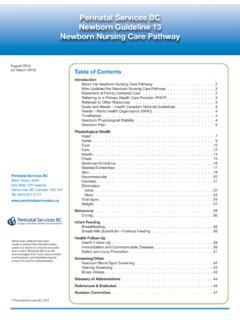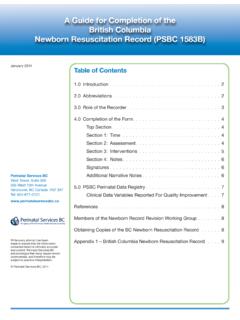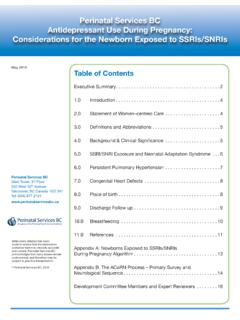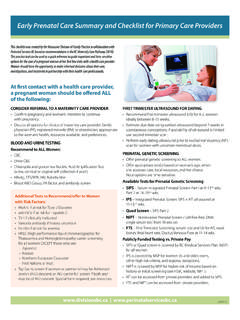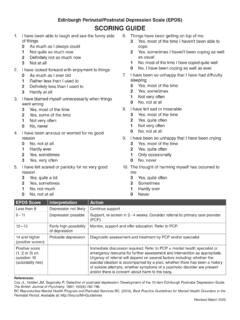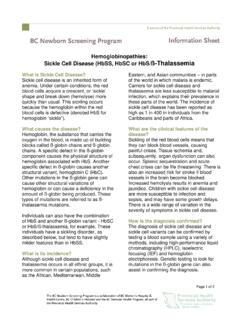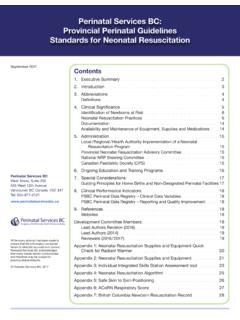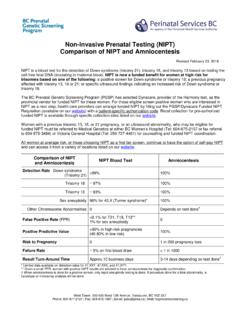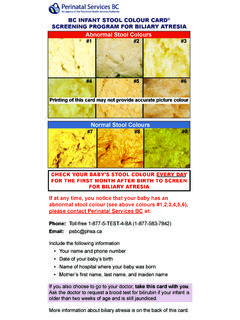Transcription of PSBC: Standards for Obstetrical Ultrasound …
1 Perinatal Services BCStandards for Obstetrical Ultrasound AssessmentsTable of ContentsINTRODUCTION 21 0 DEFINITIONS, LICENSURE & CERTIFICATION REQUIREMENTS, SAFETY CONSIDERATION 3 Definitions 3 Licensure & Certification Requirements 3 Safety Consideration 32 0 ABNORMAL OR UNEXPECTED FINDINGS 33 0 STANDARDIZED CHARTS AND FORMULAS 44 0 MINIMUM REQUIRED CONTENT 64 1 ALL OB Ultrasound Reports 64 2 1st Trimester Ultrasound Report (up to and including 14wks 0d)
2 74 3 2nd Trimester Ultrasound Report (14wks 1d 26wks 6d) 84 4 3rd Trimester Ultrasound Report (27wks 0d term) 105 0 REFERENCES 116 0 DEVELOPMENT COMMITTEE MEMBERS 12 APPENDIX 1 SAMPLE SONOGRAPHER WORKSHEET 13 APPENDIX 2 REQUIRED IMAGE DOCUMENTATION 14 APPENDIX 3 PW DOPPLER USE IN OBSTETRIC Ultrasound 17 APPENDIX 4 CONTACT INFORMATION AND FDS REFERRAL CRITERIA 19 APPENDIX 5 PGSP MINIMUM REPORTING Standards FOR NUCHAL TRANSLUCENCY Ultrasound MEASUREMENTS 20 APPENDIX 6 CROWN RUMP LENGTH (CRL) CHART 22 APPENDIX 7 INTERGROWTH 21ST FETAL GROWTH Standards REVIEW 23 APPENDIX 8 AMNIOTIC FLUID VOLUME 24 APPENDIX 9 SOGC 1ST TRIMESTER DATING Ultrasound 27 APPENDIX 10 FETAL SEX DETERMINATION POLICY 28 APPENDIX 11 FETAL SOFT MARKERS 29 APPENDIX 12 SOGC FETAL HEALTH SURVEILLANCE: ANTEPARTUM AND INTRAPARTUM CONSENSUS GUIDELINE 31 APPENDIX 13 ISUOG PRACTICE GUIDELIES.
3 USE OF DOPPLER ULTRASONOGRAPHY IN OBSTETRICS 32 APPENDIX 14 CAR STANDARD FOR PERFORMING DIAGNOSTIC OBSTETRIC Ultrasound EXAMINATIONS 33 APPENDIX 15 CAR STANDARD FOR COMMUNICATION OF DIAGNOSTIC IMAGING FINDINGS 34 APPENDIX 16 SOGC CONTENT OF A COMPLETE ROUTINE SECOND TRIMESTER Obstetrical Ultrasound EXAMINATION AND REPORT 35 APPENDIX 17 SOGC FETAL SOFT MARKERS IN OBSTETRIC Ultrasound 36 While every attempt has been made to ensure that the information contained herein is clinically accurate and current, Perinatal Services BC acknowledges that many issues remain controversial, and therefore may be subject to practice interpretation Perinatal Services BC, 2014 Perinatal Services BC West Tower, Suite 350 555 West 12th Avenue Vancouver, BC Canada V5Z 3X7 Tel.
4 December 1, 20152 Perinatal Services BCIn September 2011, the BC Patient Safety and Quality Council produced a report entitled Investigation into Medical Imaging, Credentialing and Quality Assurance The report reviewed the existing structure for the licensing and credentialing of physicians in BC s health authorities, including the processes for quality assurance and peer review Recommendation #32 in the report designated Perinatal Services BC (PSBC) to develop or adopt and promulgate Standards for Obstetrical Ultrasound assessments in the first, second and third trimesters that are performed in community and tertiary facilities In December 2011, PSBC brought together a multidisciplinary committee to develop Standards for the required minimum content of an obstetric Ultrasound assessment The committee included radiologists and sonographers from rural and urban areas of practice and both the public and private sector as well as perinatologists Additional clinical consultation was provided by obstetricians, family physicians, and midwives Representatives from the BC Radiology Society (BCRS), BC Ultrasonographers Society (BCUS)
5 , 2 Lower Mainland Medical Imaging Integration and the Diagnostic Accreditation Program also provided information and consultation Standards and clinical practice guidelines from the Canadian Association of Radiologists, the Society of Obstetricians and Gynaecologists of Canada and the International Society of Ultrasound in Obstetrics and Gynecology provided a framework for the BC Standards In early 2015, the Standards were reviewed through the same multidisciplinary process as above and updated to reflect feedback and new clinical practice guidelines published by the Society of Obstetricians and Gynaecologists of Canada and the International Society of Ultrasound in Obstetrics and Gynecology in 2013 and 2014 It is the intention of these Standards to ensure a consistent level of care throughout the province surrounding the provision of Obstetrical Ultrasound that is based on current clinical best practices The Standards provide a simple, single source of information regarding assessment criteria for physicians and sonographers involved in obstetric ultrasounds at diagnostic and screening sites around the province This document is not intended to confine or limit Ultrasound assessment parameters as individual diagnostic imaging sites may include additional Ultrasound components dependent on available expertise, clinical indication.
6 And health care provider requests In order to ensure that these provincial Standards continue to align with best practices, they will be reviewed when new best practices and/or clinical practice guidelines are published The review will be led by Perinatal Services BC and performed by a multidisciplinary group consisting of representation from different health care provider stakeholders, health authorities, and both public and private facilities Introduction3 Standards for Obstetrical Ultrasound AssessmentsDefinitions Ultrasound Report The document that provides the findings of the Ultrasound assessment including all of the items listed in this document It is signed by a qualified physician and is distributed to the ordering health care provider (HCP) and other HCPs as requested Sonographer Worksheet A document used by the sonographer during an Obstetrical (OB) Ultrasound assessment Not considered to be an Ultrasound Report Sample Appendix 1 Image documentation Images which are assessed and retained These images are stored by the diagnostic imaging site A list of required images to be assessed and retained which support the required content for an OB Ultrasound report is included Appendix 2 For the purposes of this document trimesters are defined as.
7 1st up to and including 14wks 0d 2nd (mid trimester) 14wks 1d 26wks 6d 3rd after and including 27wks 0dLicensure & Certification Requirements Individuals providing OB Ultrasound reports and individuals performing OB ultrasounds are required to have the appropriate licensure and credentials as per the provincial regulatory authorities Safety Consideration While performing an Ultrasound , exposure time and acoustic output should be kept to the lowest levels consistent with obtaining diagnostic information and limited to medically indicated procedures Appendix Abnormal or Unexpected FindingsSince the first identification of a clinically significant finding is often not anticipated by the referring care provider and may require immediate attention and case management decisions, verbal communication with the referring care provider, in advance of the final written report, is strongly recommended. When abnormal or unexpected findings are identified, the Ultrasound examination must be expanded appropriately and all abnormal findings documented, measured (if appropriate) and reported When significant fetal growth and/or fluid volume abnormalities and/or structural malformations are identified, recommendations given in the final report should include a referral to, or consultation with, the Fetal Diagnostic Service (FDS), the Provincial Medical Genetics Program, or other specialists Appendix 4 When a fetal soft marker(s) is (are) identified, recommendations given in the final report may include referral to, or consultation with, the Provincial Medical Genetics Program, or other specialists The website for the BC Prenatal Genetic Screening Program (PGSP) also provides helpful information When a nuchal translucency (NT)
8 Measurement is above the established cut off, recommendations given in the final report should include standard comments as determined by the BC Prenatal Genetic Screening Program Appendix Definitions, Licensure & Certification Requirements, Safety Consideration4 Perinatal Services BCCROWN RUMP LENGTH (CRL)The recommended reference chart (unpublished) for crown rump length (CRL) is from data obtained at the same time as the Lessoway et al, Ultrasound fetal biometry charts for a North American Caucasian population study (referenced below) using the same methods and analysis This chart is currently used by many of the diagnostic imaging sites in BC and the BC Prenatal Genetic Screening Program (PGSP) Appendix 6 ANATOMIC MEASUREMENTS*The recommended reference charts for measurement of head circumference (HC), femur length (FL), biparietal diameter (BPD), abdominal circumference (AC) and thorax circumference (TC) are: Lessoway V, Schulzer M, Wittmann B, et al Ultrasound fetal biometry charts for a North American Caucasian population J Clin Ultrasound 1998 Nov-Dec;26(9):433 53.
9 GROWTH PARAMETERSThe newborn birth weight, length and head circumference charts used by the BC Perinatal Data Registry (PDR) are from the BC Ministry of Health Vital Statistics Agency and are based on BC data (1981 to 2000) FLUID VOLUMEA mniotic fluid assessment should be performed using the Single Deepest Pocket (SDP) method The modernized description for performing an amniotic fluid volume assessment using the Single Deepest Pocket method is based on: Chamberlain et al Ultrasound evaluation of amniotic fluid volume I The relationship of marginal and decreased amniotic fluid volumes to perinatal outcome Am J Obstet Gynecol. 1984;150(3):245 9. Chamberlain et al Ultrasound evaluation of amniotic fluid volume II The relationship of increased amniotic fluid volume to perinatal outcome Am J Obstet Gynecol. 1984;150(3):250 Description: The largest pocket of fluid free of cord and fetal parts is identified and its depth (cm) measured as close to right angles as possible to the uterine contour The pocket must be at least 1 cm in width (width being measured perpendicular to the depth axis) at its narrowest point so that it is at least 1 cm wide throughout the measured depth axis To avoid over-estimation of pocket depth, the transducer should not be over-angled through the pocket relative to the depth axis * NOTE.
10 A Working Group on biometric Standards for assessing fetal growth was brought together to carefully consider the option of replacing the current, widely used, Lessoway standard with the new Intergrowth 21st standard The Intergrowth 21st international standard was developed on the basis of recommendations from a WHO expert committee and the study was funded by the Bill and Melinda Gates Foundation The Working Group carefully examined contemporary data from British Columbia, which included cohorts at risk for growth restriction and macrosomia as well as a low risk normal cohort The analysis showed that adopting the Intergrowth standard would lead to a significant decrease in the frequency of small-for-gestational age diagnoses and a substantial increase in large-for-gestational age diagnoses The Working Group found this concerning, especially since the under identification of small fetuses has the potential for increasing mortality and serious morbidity, while the excess number of large fetuses identified would drastically increase the need for clinical resources The Working Group recommends that the Lessoway standard remain the provincial standard For more details see Appendix Standardized Charts and Formulas5 Standards for Obstetrical Ultrasound AssessmentsSINGLE DEEPEST POCKET (SDP) INTERPRETATION*DEFINITIONSO ligohydramnios: SDP < 2 0 cm Normal: SDP between 2 0 and 8 0 cm Polyhydramnios: SDP > 8 0 cmAbnormalities of amniotic fluid using these simple cutoffs should occur less than 3% of time in a controlled population up to term Magann et al The amniotic fluid index, single deepest pocket, and two diameter pocket in normal human pregnancy Am J Obstet Gynecol.
